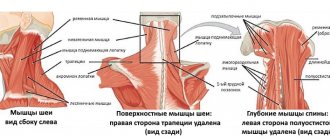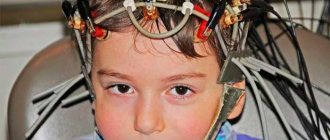What is the Romberg test for?
The Romberg test is traditionally used to study the functions of the nervous system, and in particular, neuromuscular relationships, which is why it is called the “coordination test.” Using this test, you can evaluate the indicators of the subject’s static coordination, i.e. assess the body's ability to maintain balance.
It has been noted that under the influence of physical education and sports, coordination of movements improves, however, with overwork or diseases of the nervous system, a disorder of coordination of movements and imbalance are observed.
The Romberg coordination test can also be used during sports activities (for example, before and after exercise). A decrease in the time required to perform the Romberg test is observed during fatigue, overexertion, during periods of illness, as well as during long breaks in physical education and sports.
In addition, studies began to appear in the sports medical literature that the Romberg test can be used not only to assess the state of the nervous system, but also to assess the psyche.
Romberg test, how are the results assessed?
The results of the Romberg test can be assessed independently. But only a doctor can make an accurate diagnosis, based on the results of several examinations. Here's the simplest interpretation:
- If a person stands calmly and confidently, this is the norm. If there is swaying, it is important to note how long after it began.
- It is also necessary to note in which direction the patient is being “taken” - forward, backward, left or right.
- Does ataxia (that is, staggering) become stronger if the subject closes his eyes.
- Do your eyelids, your toes or hands, or your torso itself tremble?
If a person was able to stand quietly without these symptoms for the allotted time, then we can assume that he does not have functional disorders of the nervous system. Since he passed the Romberg test successfully. If the “alarm bells” described above appear, then this means only one thing - you need to consult a doctor.
Only he will be able to correctly interpret the results from a medical point of view. And determine the order of further important actions.
Children who do not play any sports have different standards for maintaining a calm state. Here are the standards in seconds of the Romberg test for time for children of different ages:
- child 7 years old – 16 seconds;
- children 8 years old – 21 seconds;
- for a child 9 years old – 24 seconds;
- for children 10 years old – 28 seconds;
- children 11 years old – 30 seconds;
- for children 12 years old – 36 seconds;
- children 13 years old – 44 seconds;
- for teenagers 14 years old – 48 seconds;
- teenagers 15 years old – 50 seconds;
- for boys and girls from 16 to 18 years old - from 51 to 53 seconds, respectively.
How to perform a simple Romberg test for adults
- The subject stands standing with support on two legs (heels together, toes slightly apart), eyes closed, arms extended forward, fingers slightly spread and relaxed.
- Another option is to have the subject stand with his feet (heels and toes) closed together, eyes closed, arms extended forward, fingers slightly spread and relaxed ( Romberg pose 1 )
- The time and degree of stability are determined (the subject stands motionless or sways) in this position, and attention is also paid to the presence of trembling - tremor of the eyelids and fingers.
Self-testing
In many ways, balance testing depends on what kind of deviation is being diagnosed. In order for the patient to take the correct position, he needs to stand straight, with his legs pressed tightly against each other.
Next, the patient should stretch his arms in front of him and close his eyes. But test variants are possible when the eyes are closed, but the arms remain in a lowered position along the body. In this situation, the doctor must support the patient, preventing falls and injuries.
If we talk about the sphere of neurological abnormalities, then with this position any staggering is taken into account and the main task of checking the Romberg symptom is to determine the degree of stability. Time intervals are also taken into account, which are also important for correct diagnosis.
A more difficult version of the test involves placing your legs so that they are on the same line. This happens as follows: the patient places his feet so that the heel (for example, the right foot) is in contact with the toes (of the left foot) and they are on the same line.
In this position, the patient should extend his arms in front of him and close his eyes. An option is possible in which the head is thrown back.
Quite often, the Romberg test is taken at home, in no case to establish a diagnosis, but rather as proof that everything is fine with the person. Sometimes, with the help of such home testing, you can identify the problem, if any, in time and seek help from specialists.
If such a test is carried out at home, there must be another person present who can provide protection and prevent a possible fall. When a person is confident in his health and strength, he can use a more complicated version of the pose, which will allow him to more accurately assess his state of health.
There are approximate time data for which a person must stand in this position. If we talk about young people, it is considered normal for them to stand in this position for 30 seconds, but here it is worth taking into account the person’s physical fitness.
Sports play a significant role; if a person is physically developed and plays sports, the result of 30 seconds is absolutely normal for him. When a person leads a passive lifestyle and does not exercise, the time interval can be reduced.
It is worth considering the fact that with age, completing this test becomes more difficult and the time frame is reduced. So for an adult, the time he must hold in this position is 6 seconds, which is considered a very good result.
If there are obvious deviations during the procedure, you should definitely contact a specialist. Since the disease detected in time is much faster to treat than advanced forms. In addition, it is worth remembering that any disease can cause complications and bring many more complications.
The most important thing is to provide the diagnosis to a specialist, and not to diagnose yourself. In such situations, it is unacceptable to take medications based on self-conducted tests.
How to conduct a complicated Romberg test for adults
Romberg test 2
- The subject's legs are on the same line. The heel of one rests on the toe of the other.
- The eyes are closed, the arms are extended forward, the fingers are slightly apart and relaxed ( Romberg pose 2 ).
- The time and degree of stability are determined (the subject stands motionless or sways) in this position, and attention is also paid to the presence of trembling - tremor of the eyelids and fingers.
Romberg test 3
- Stand on one leg, resting the sole of the other leg on the kneecap of the supporting leg.
- The eyes are closed, the arms are extended forward, the fingers are slightly apart and relaxed ( Romberg pose 3 ).
- The time and degree of stability are determined (the subject stands motionless or sways) in this position, and attention is also paid to the presence of trembling - tremor of the eyelids and fingers.
How testing is carried out
In many ways, balance testing depends on what kind of deviation is being diagnosed. In order for the patient to take the correct position, he needs to stand straight, with his legs pressed tightly against each other.
Next, the patient should stretch his arms in front of him and close his eyes. But test variants are possible when the eyes are closed, but the arms remain in a lowered position along the body. In this situation, the doctor must support the patient, preventing falls and injuries.
If we talk about the sphere of neurological abnormalities, then with this position any staggering is taken into account and the main task of checking the Romberg symptom is to determine the degree of stability. Time intervals are also taken into account, which are also important for correct diagnosis.
A more difficult version of the test involves placing your legs so that they are on the same line. This happens as follows: the patient places his feet so that the heel (for example, the right foot) is in contact with the toes (of the left foot) and they are on the same line.
In this position, the patient should extend his arms in front of him and close his eyes. An option is possible in which the head is thrown back.
Diagnosis of Parry Romberg syndrome in practice:
General assessment of the Romberg test results
The duration of stable standing in the Romberg position, the presence or absence of trembling of the eyelids, hands, and swaying of the body are assessed.











